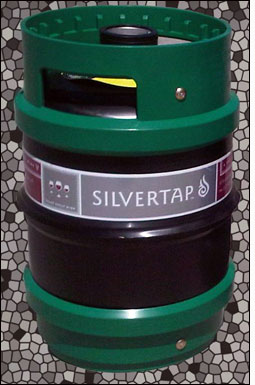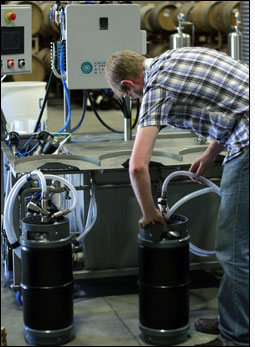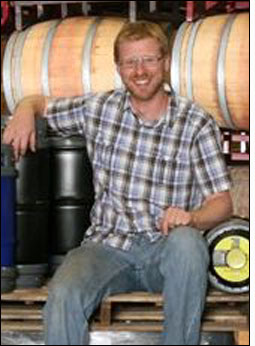There are no bottles at Free Flow Wines‘ Sonoma facility, where the vintner produces, stores and then ships its six varieties of Silvertap organic wines, made from grapes grown at sustainable Sonoma County vineyards. Instead, the company employs recyclable plastic kegs, thereby reducing its environmental impact, and providing restaurants and bars with a wine-by-the-glass option that challenges a tradition of wine sold in bottles. Nitrogen gas pushes the wine out of the cask, preserving the wine remaining in the keg for months. To track those casks’ location and status, and to ensure they are returned, properly cleaned and refilled, the company is utilizing radio frequency identification.

Free Flow Wines opened its doors just over a year ago, and currently sells 200 to 300 kegs of Silvertap wine monthly, shipped via distributors to restaurants and bars throughout the United States (most of which have been in the San Francisco Bay area to date). As the company grows, however, it requires an automated system to track the locations of those reusable kegs. RFID technology seemed to be the solution, says Jordan Kivelstadt, Free Flow Wines’ founder and director of production. The wine company is using a system provided by Mobile BIS, a division of BIS Computer Solutions Inc.
Free Flow Wines has finished tagging all of its kegs in the past few weeks, and has now begun shipping them to distributors. If the system works as planned, Kivelstadt expects it to provide an automated tracking solution that will reduce the frequency at which casks would otherwise be lost—an expensive and common occurrence for the beer and wine industry. He also intends to use the system to ensure that kegs are properly cleaned and reused in a timely manner, and that all kegs could quickly be located in the event of a recall. The company will know when a percentage of its casks are not returned by a distributor, and can then respond appropriately to investigate to whom they were shipped, and when. What’s more, by knowing when the kegs are returned, the company can return deposits to distributors more quickly than with a manual count method.

Prior to adopting RFID, the firm had considered its options and rejected the idea of placing a serialized bar-code label on each cask. “The big issue for us was we didn’t want to use a bar-code system,” Kivelstadt states, “because scanning bar codes on kegs would have to be done one at a time.”
With the RFID system, each keg has a UPM Raflatac DogBone ultrahigh-frequency (UHF) EPC Gen 2 tag embedded by the keg manufacturer between the keg and the plastic handle encircling the top of that keg. Free Flow Wines encoded each tag with a unique ID number after the tags were embedded into a total of 4,800 casks.

When a keg is filled with one of the company’s six wines, staff members use a Psion Teklogix Workabout Pro handheld computer with a built-in RFID reader module to capture the unique ID of each keg in the batch, and also enter the time, the date and the variety of wine that keg has been filled with. The data is then transmitted, via a Wi-Fi Internet connection, to a server hosted by Mobile BIS, where the information is stored in an Oracle 10g database.
Free Flow Wines’ management can then access the data by logging onto a Web-based application. There are four additional read points in the process: when a keg is shipped to a distributor (at which time the distributor’s name is input into the handheld), when it returns from the distributor, when it is cleaned and when it is inspected for damage.
The software on the server was designed specifically for this application, according to Michael Macho, Mobile BIS’ president. The system enables Free Flow Wines to establish its own rules, such as adding additional read points or setting up alerts. For instance, the system could send an e-mail or text message to employees if a keg reaches a specified maximum storage time at a distributor’s facility. “It could also provide business analytics,” Macho says—indicating, for example, the number of casks of wine bought by any specific distributor over the course of a year, or the rate at which particular wines are selling.
In the near future, Kivelstadt says, the wine company anticipates selling thousands of kegs of wine each month, and the RFID system is expected to make that possible by reducing a keg’s turnaround time, as well as ensuring that its return from a distributor is processed quickly, and that it is cleaned and refilled as fast as possible. Kivelstadt does not expect the company’s distributors to use RFID readers themselves, as each has its own existing management system for tracking product through its facilities.

